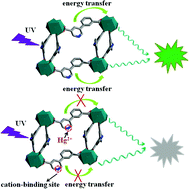A highly luminescent terbium–organic framework for reversible detection of mercury ions in aqueous solution†
Abstract
A new organic–lanthanide framework [TbL1.5(H2O)2]·H2O (1) [H2L = 5-(3′-carboxylphenyl)nicotinic acid] was synthesized. Its structure was determined by


 Please wait while we load your content...
Please wait while we load your content...